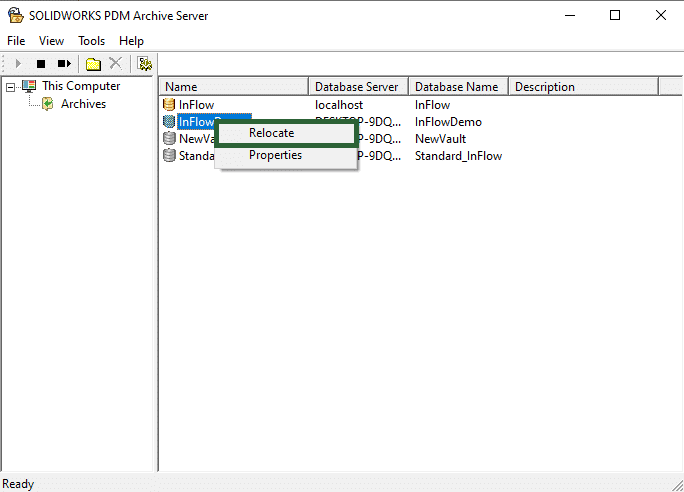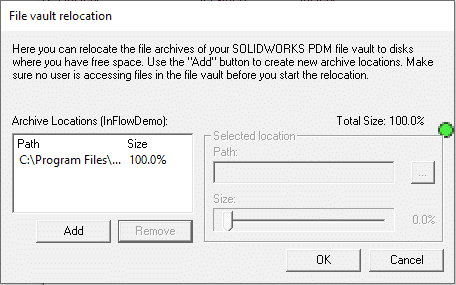Large Archive Servers in SOLIDWORKS PDM
You might notice that Archive Servers balloon pretty quickly. Ever wonder why that is? Well, the archive server stores ever version of every file in SOLIDWORKS PDM. So, if you have a file that has 15 versions, there are going to be 15 individual files in the PDM archive. As you add more and more files, that archive will grow and grow. As you can imagine, it becomes pretty important to know how to work with large archive servers in SOLIDWORKS PDM. Let’s talk about exactly that. First, we’ll define what would be a large archive database. Then, we’ll introduce a few methods you have that can help keep the archive at bay.
Defining a Large Archive Server

No, 50GB is not a large server. Also, no 100GB is not a large server. Or maybe that is large. My definition of a large archive server may be different than your definition. What we’re going to be discussing is how to handle whatever you define as large. For me, I generally would consider “large” as 250GB or larger. The trick is knowing where to find that information. Well, it’s easier to find than you think.
To figure out the size of your archive server, go to the following folder path on the archive server machine:
- C:\Program Files\SOLIDWORKS Corp\SOLIDWORKS PDM\Data\[VAULT NAME]
This path does assume you’re using the default file path. If your administrator distributed the archive (more on that later) or if it’s not local, check out this help file from SOLIDWORKS.
All you have to do is right-click on the vault name folder and select Properties. Now you have a view of roughly how many files are in your vault as well as the size. I say roughly because this includes all history as individual files. Additionally, there could be other files for formatting that you wouldn’t include in a file count.
Now that we’ve defined a large server, what can you do to manage it? In a dire situation, you can always move your file archives to a new server. You may want to do this when you’re just out of space, maybe have an older machine, and want a fresh start. However, not everybody has the resources or desire for setting up a new server. Instead, let’s talk about how we can manage a larger file archive.
Managing a Large Archive Server
Distributed File Archives
My SOLIDWORKS PDM environment is not the same as yours. My archive server might be 10TB (it isn’t) and yours might be 100GB. So it’s important that you maintain the data. In some instances, maintaining that data means distributing the archive to multiple drives. These drives could be additional drives on the same server or somewhere else on your domain. So, if you’re running low on space, this could be an appealing option for expanding your system.
To activate distribution, start in the archive server configuration tool. Once there, right-click on your vault and select Relocate.
Now, you’ll see a dialogue outlining your current allocation of the vault. If there’s no distribution, you should see something like this.

I do want to note that your smallest possible vault fragment is 1/16th of the vault. So no, you can’t have 100 different drives with each having 1% of the vault.
What you can do here is add more drive locations for the archive server to save files. As I said earlier, these drives can be anywhere that you have access to. I would recommend that these drives stay local to that server for performance reasons. Moving the drive farther away means more data users have to pull over the network. Keeping everything on the same intranet will give you better performance when getting your files.
Distributing the archive across multiple drives is a great way to make sure no one drive gets overloaded. But you might not have access to multiple drives and want to compress what you can. For that, we want to take a look at activating compression on the Archive Server.
Activating Compression
As I mentioned at the top, the archive server keeps every version of a file. But sometimes having every version active at the same time doesn’t make sense. Think about it; I have 32 versions of an assembly going back 3 years. How often will I access version 3? Likely not all that often. So what can we do to manage that? Well cold storage is a great tool for moving or deleting old versions from the archive server. That’s one thing you can do to pair it with distributed file archives, but what if you only have one drive dedicated to PDM?
That’s where activating archive compression comes in. Justin Webster wrote a blog about that exact thing a few years back and it’s a great resource to learn more. Let me give you the high level overview. Archive compression isn’t activated by default. Instead, the server keeps every file at full size. So, by turning on compression, PDM will compress every version of a file that isn’t the latest version.
What this does for you is it keeps the latest version in an optimal format for use. It also makes sure that you don’t lose older files or move them someplace that’s difficult to access, like Cold Storage might. Everything stays on a single server for easy access. When you want to grab an older file, the archive server decompresses the file and you access it like normal.
Next Steps
There are steps to work with large archive servers. Some people get 10TB hard drives to make sure they never run out of space. Others, however, may not be so lucky. So to help reduce the need for insanely large hard drives, there are a few things we can look into.
If you have enough space on your server, no need to rush into compressing or distributing your archives. However, planning ahead can make sure you don’t run into any problems in the future. For some people, the future is now. So what can you do to minimize your vault impact? If you can, work out a plan to distribute your files across multiple drives. Ensure those drives are on your local network and they can handle the load from the archive server.
An additional step you should look into is compressing your archives. Compression works on every file in the archives that’s not the latest version, ensuring you don’t lose time getting compressed files. This is a great option to minimize the impact each file has on the storage space. There are a few high-level configuration steps, so understanding what each section means can improve your configuration.

 Blog
Blog